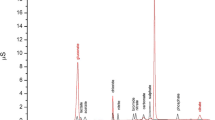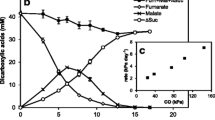Abstract
Production of nitrate reductase was studied in 15 species of microscopic fungi grown on a nitrate-containing medium. Experiments were performed with Fusarium oxysporum 11dn1, a fungus capable of producing nitrous oxide as the end product of denitrification. Moreover, a shift from aerobic to anaerobic conditions of growth was accompanied by a sharp increase in the activity of nitrate reductase. Studies of nitrate reductase from the mycelium of Fusarium oxysporum 11dn1, grown under aerobic and anaerobic conditions, showed that this enzyme belongs to molybdenum-containing nitrate reductases. The enzymes under study differed in the molecular weight, temperature optimum, and other properties. Nitrate reductase from the mycelium grown under aerobic conditions was shown to belong to the class of assimilatory enzymes. However, nitrate reductase from the mycelium grown anaerobically had a dissimilatory function. An increase in the activity of dissimilatory nitrate reductase, observed under anaerobic conditions, was associated with de novo synthesis of the enzyme.
Similar content being viewed by others
Abbreviations
- BPB:
-
bromophenol blue
- MV:
-
methyl viologen
- NRase:
-
nitrate reductase
- NIRase:
-
nitrite reductase
- NORase:
-
nitric oxide reductase
- PMSF:
-
phenylmethylsulfonyl fluoride
REFERENCES
Zumft, W.G., Microbiol. Mol. Biol. Rev., 1997, vol. 61, pp. 553–616.
Philippot, L. and Hojberg, O., Biochim. Biophys. Acta, 1999, vol. 1446, pp. 1–23.
Moreno-Vivian, C., Cabello, P., Martinez-Luque, M., Blasco, R., and Castillo, F., J. Bacteriol., 1999, vol. 181, pp. 6573–6584.
Zvyagil’skaya, R.A., Vartapetyan, B.B., and L’vov, N.P., Prikl. Biokhim. Mikrobiol., 1996, vol. 38, no.2, pp. 179–184.
Tsuruta, S., Takaya, N., Zhang, L., Shoun, H., Kimura, K., Hamamoto, M., and Nakase, T., FEMS Microbiol. Lett., 1998, vol. 168, pp. 105–110.
Takaya, N., J. Biosci. Bioeng, 2002, vol. 94, pp. 506–510.
Zhou, Z., Takaya, N., Sakairi, M.A.C., and Shoun, H., Arch. Microbiol., 2001, vol. 175, pp. 19–25.
Shown, H. and Tanimoto, T., J. Biol. Chem., 1991, vol. 266, pp. 11078–11082.
Shown, H., Kim, D.H., Uchiyama, H., and Sugiyama, J., FEMS Microbiol. Letts., 1992, vol. 73, pp. 277–281.
Shown, H., Kim, D.H., Baba, I., Takaya, N., and Matsuo, M., J. Bacteriol., 1998, vol. 180, pp. 4413–4415.
Kobayashi, M. and Shoun, H., J. Biol. Chem., 1995, vol. 270, pp. 4146–4151.
Kizawa, H., Tomura, D., Oda, M., Fukamizu, A., Hoshiro, T., Gotoh, O., Yasui, T., and Shoun, H., J. Biol. Chem., 1991, vol. 266, pp. 10632–10637.
Nakahara, K. and Shoun, H., J. Biochem., 1996, vol. 120, pp. 1082–1087.
Takaya, N., Suzuk, S., Kuwazaki, S., Shoun, H., Maruo, F., Yamaguchi, M., and Takeo, K., Arch. Biochem. Biophys., 1999, vol. 372, pp. 340–346.
Nakahara, K., Tanimoto, T., Hatano, K., Usuda, K., and Shoun, H., J. Biol. Chem., 1993, vol. 268, pp. 8350–8355.
Kurakov, A.V., Pakhnenko, O.A., Kostina, N.V., and Umarov, M.M., Pochvovedenie, 1997, vol. 30, pp. 1344–1349.
Kurakov, A.V., Nosikov, A.N., Skrynnikova, E.V., and L’vov, N.P., Curr. Microbiol., 2000, vol. 41, pp. 114–119.
Uchimura, H., Enjoji, H., Seki, T., Taguchi, A., Takaya, N., and Shoun, H., J. Biochem., 2002, vol. 131, pp. 579–586.
Takaya, N., Kuwazaki, S., Adachi, Y., Suzuki, S., Kikuchi, T., Nakamura, H., Shiro, Y., and Shoun, H., J. Biochem., 2003, vol. 133, pp. 461–465.
Bradford, M.A., Anal. Biochem., 1976, vol. 72, pp. 248–254.
Hawkes, T.R. and Bray, R.C., Biochem. J., 1984, vol. 219, pp. 481–493.
Losada, M., J. Mol. Catalysis, 1975, vol. 76, pp. 245–254.
Minagawa, H. and Yoshimoto, A., Argon. Biol. Chem., 1984, vol. 48, pp. 557–559.
Horner, R.D., Biochim. Biophys. Acta, 1983, vol. 744, pp. 7–15.
Author information
Authors and Affiliations
Additional information
__________
Translated from Prikladnaya Biokhimiya i Mikrobiologiya, Vol. 41, No. 3, 2005, pp. 292–297.
Original Russian Text Copyright © 2005 by Morozkina, Kurakov, Nosikov, Sapova, L’vov.
Rights and permissions
About this article
Cite this article
Morozkina, E.V., Kurakov, A.V., Nosikov, A.N. et al. Properties of nitrate reductase from Fusarium oxysporum 11dn1 fungi grown under anaerobic conditions. Appl Biochem Microbiol 41, 254–258 (2005). https://doi.org/10.1007/s10438-005-0043-3
Received:
Issue Date:
DOI: https://doi.org/10.1007/s10438-005-0043-3




